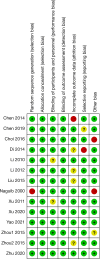Efficacy and safety of neostigmine for neuromuscular blockade reversal in patients under general anesthesia: a systematic review and meta-analysis
- PMID: 34988200
- PMCID: PMC8667102
- DOI: 10.21037/atm-21-5667
Efficacy and safety of neostigmine for neuromuscular blockade reversal in patients under general anesthesia: a systematic review and meta-analysis
Abstract
Background: Since the antagonistic effect of neostigmine on muscle relaxation is still controversial, this study aimed to evaluate the efficacy and safety of neostigmine for the reversal of neuromuscular blockade in patients recovering from general anesthesia.
Methods: Multiple databases, including PubMed, Web of Science, the Cochrane Library, and Chinese National Knowledge Infrastructure (CNKI), were electronically searched up to August 2021. Relevant studies on the use of neostigmine for neuromuscular blockade reversal in patients under general anesthesia were retrieved. Two reviewers independently screened and extracted data from the retrieved studies, and assessed their risk of bias. Review Manager 5.2 was used to evaluate the efficacy and safety of neostigmine based on the included articles. Heterogeneity and related subgroup, sensitivity, and bias analyses were carried out.
Results: The analysis included 14 studies involving 2,109 patients, including 1,209 in the neostigmine group and 990 in the control group. Results from the random-effects model showed that neostigmine reduced the length of stay in the post-anesthesia care unit [mean difference (MD) =-17.73; 95% confidential interval (CI): -22.06 to -13.41; P<0.0001], the time to recovery of train-of-four ratio ≥0.9 (MD =-16.60; 95% CI: -23.67 to -9.52; P<0.0001), and the extubation time (MD =-16.69; 95% CI: -28.22 to -5.17; P=0.005). However, no difference was observed in adverse events between the neostigmine and control groups [odds ratio (OR) =0.97; 95% CI: 0.84-1.12; P=0.71]. Subgroup analyses adjusted for the dosage of neostigmine had no effect on the above results.
Conclusions: Neostigmine can effectively and safely enhance neuromuscular recovery from non-depolarizing muscle relaxants in patients under general anesthesia.
Keywords: Neostigmine; anesthesia; neuromuscular blockade.
2021 Annals of Translational Medicine. All rights reserved.
Conflict of interest statement
Conflicts of Interest: All authors have completed the ICMJE uniform disclosure form (available at https://dx.doi.org/10.21037/atm-21-5667). The authors have no conflicts of interest to declare.
Figures









Comment in
-
Is neostigmine safe and effective for neuromuscular blockade reversal in patients recovering from general anesthesia?Ann Transl Med. 2022 Apr;10(8):498. doi: 10.21037/atm-22-309. Ann Transl Med. 2022. PMID: 35571393 Free PMC article. No abstract available.
References
LinkOut - more resources
Full Text Sources
